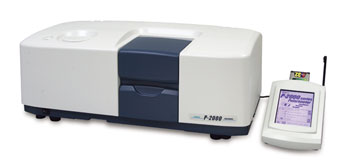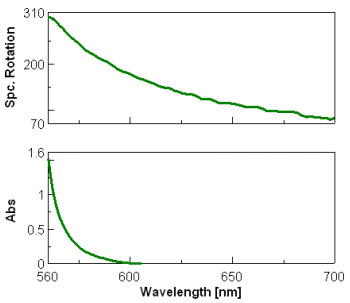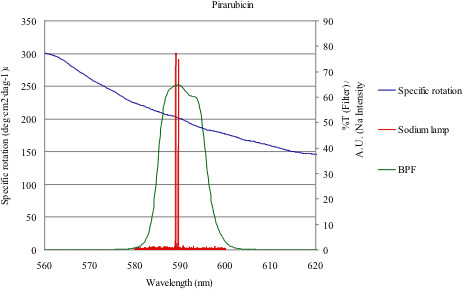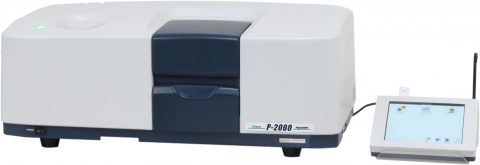High Accuracy Optical Rotation Measurement of Pirarubicin using Sodium and Halogen Lamps
January 5, 2024
Introduction

The phenomena of optical was first identified more than two centuries ago. This measurement was popularized by the use of a convenient low pressure sodium lamp with a strong emission line at 589nm.
In modern polarimeters emission lines of light sources such as a sodium and mercury lamps are often used to measure the high accuracy optical rotation of pharmaceutical products. However, both the Japanese Pharmacopeia (JP) and the European Pharmacopeia (EP) currently only recommend the use of a low pressure sodium lamp as a compliant light source.
With improved interference filters it is now possible to use a polarimeter with a broad spectrum halogen lamp and a narrow wavelength band pass filter (BPF). This is mentioned as an acceptable method by the United States Pharmacopeia (USP). However, the measurement error from the transmission property, that is the difference between the center wavelength of the BPF and the wavelength of the Na 589 emission line, should be considered.
To demonstrate this, the optical rotation of pirarubicin was measured using a P-2000 polarimeter with both sodium and halogen lamps, and the measurement accuracy between the results was evaluated.
ORD measurement
Sample preparation
10.00 mg of pirarubicin was dissolved in chloroform and made up to a final volume of 10 ml.
System
Parameters
| Cell pathlength: | 20 mm |
| Data interval: | 0.2 nm |
| Temperature: | 20°C |
| Response: | 1 sec |
| Accumulation: | 1 |
| Bandwidth: | 1 nm |
| Scan speed: | 100 nm/min |
Keywords
260-PL-0004
Results
First, the absorption and ORD spectra of pirarubicin were measured in the region of 700-560 nm to confirm the wavelength dependence of the optical rotation (Fig. 1). The absorbance increased sharply below 600 nm and optical rotation increased gradually as a result of the Cotton effect.

The transmission spectrum of the BPF and the spectrum of the sodium lamp D589-line, are overlaid with the ORD spectrum and shown in Fig. 2. there is an apparent and significant change in the specific rotation in the wavelength region that passes through the relatively broad band pass of the BPF.

Optical rotation Measurement using Halogen and Sodium Lamps
Sample preparation
Identical sample as used ORD measurement.
System
- P-2000 Polarimeter
- PTC-262 Peltier thermostated cell holder
Parameters
| Measurement temp.: | 20°C |
| Cell pathlength: | 100mm |
| Wavelength: | 589 nm (D-line of sodium and halogen lamp) |
Table 1. Results of the optical and specific rotation measurements
| Light source | Optical rotation [deg] | Specific rotation [deg·cm2·dag-cm1] |
|---|---|---|
| Sodium lamp | +0.2066 | [α]D20: +206.6 |
| Halogen lamp | +0.1967 | [α]58920: +196.7 |
Conclusion
Specific rotation of the sample was first measured using ORD on a JASCO J-815 spectropolarimeter and then measured using the P-2000 fixed wavelength polarimeter. When a sodium lamp is used as the light source, the result for optical rotation was [α]D20= +206.6 [deg·cm2·dag-1]. This value falls within the range published in the Japanese Pharmacopeia. ([α]D20 = +195 ~ +215 [deg·cm2·dag-1]). When a halogen lamp was used, the specific rotation was acceptable but just inside this range ([α]D20 = +196.7 [deg·cm2·dag-1]). These two results demonstrate the potential difference in optical rotation measured at the same wavelength (589 nm) with different lamps. When considering the use of polarimetry, it is important for high accuracy and requirements for regulatory compliance to consider the potential for variation in optical rotation within the band pass of the measurement system.
Featured Products:

High Accuracy Optical Rotation Measurement of Pirarubicin using Sodium and Halogen Lamps
Introduction

The phenomena of optical was first identified more than two centuries ago. This measurement was popularized by the use of a convenient low pressure sodium lamp with a strong emission line at 589nm.
In modern polarimeters emission lines of light sources such as a sodium and mercury lamps are often used to measure the high accuracy optical rotation of pharmaceutical products. However, both the Japanese Pharmacopeia (JP) and the European Pharmacopeia (EP) currently only recommend the use of a low pressure sodium lamp as a compliant light source.
With improved interference filters it is now possible to use a polarimeter with a broad spectrum halogen lamp and a narrow wavelength band pass filter (BPF). This is mentioned as an acceptable method by the United States Pharmacopeia (USP). However, the measurement error from the transmission property, that is the difference between the center wavelength of the BPF and the wavelength of the Na 589 emission line, should be considered.
To demonstrate this, the optical rotation of pirarubicin was measured using a P-2000 polarimeter with both sodium and halogen lamps, and the measurement accuracy between the results was evaluated.
ORD measurement
Sample preparation
10.00 mg of pirarubicin was dissolved in chloroform and made up to a final volume of 10 ml.
System
Parameters
| Cell pathlength: | 20 mm |
| Data interval: | 0.2 nm |
| Temperature: | 20°C |
| Response: | 1 sec |
| Accumulation: | 1 |
| Bandwidth: | 1 nm |
| Scan speed: | 100 nm/min |
Results
First, the absorption and ORD spectra of pirarubicin were measured in the region of 700-560 nm to confirm the wavelength dependence of the optical rotation (Fig. 1). The absorbance increased sharply below 600 nm and optical rotation increased gradually as a result of the Cotton effect.

The transmission spectrum of the BPF and the spectrum of the sodium lamp D589-line, are overlaid with the ORD spectrum and shown in Fig. 2. there is an apparent and significant change in the specific rotation in the wavelength region that passes through the relatively broad band pass of the BPF.

Optical rotation Measurement using Halogen and Sodium Lamps
Sample preparation
Identical sample as used ORD measurement.
System
- P-2000 Polarimeter
- PTC-262 Peltier thermostated cell holder
Parameters
| Measurement temp.: | 20°C |
| Cell pathlength: | 100mm |
| Wavelength: | 589 nm (D-line of sodium and halogen lamp) |
Table 1. Results of the optical and specific rotation measurements
| Light source | Optical rotation [deg] | Specific rotation [deg·cm2·dag-cm1] |
|---|---|---|
| Sodium lamp | +0.2066 | [α]D20: +206.6 |
| Halogen lamp | +0.1967 | [α]58920: +196.7 |
Conclusion
Specific rotation of the sample was first measured using ORD on a JASCO J-815 spectropolarimeter and then measured using the P-2000 fixed wavelength polarimeter. When a sodium lamp is used as the light source, the result for optical rotation was [α]D20= +206.6 [deg·cm2·dag-1]. This value falls within the range published in the Japanese Pharmacopeia. ([α]D20 = +195 ~ +215 [deg·cm2·dag-1]). When a halogen lamp was used, the specific rotation was acceptable but just inside this range ([α]D20 = +196.7 [deg·cm2·dag-1]). These two results demonstrate the potential difference in optical rotation measured at the same wavelength (589 nm) with different lamps. When considering the use of polarimetry, it is important for high accuracy and requirements for regulatory compliance to consider the potential for variation in optical rotation within the band pass of the measurement system.
Keywords
260-PL-0004

 Download This Application
Download This Application